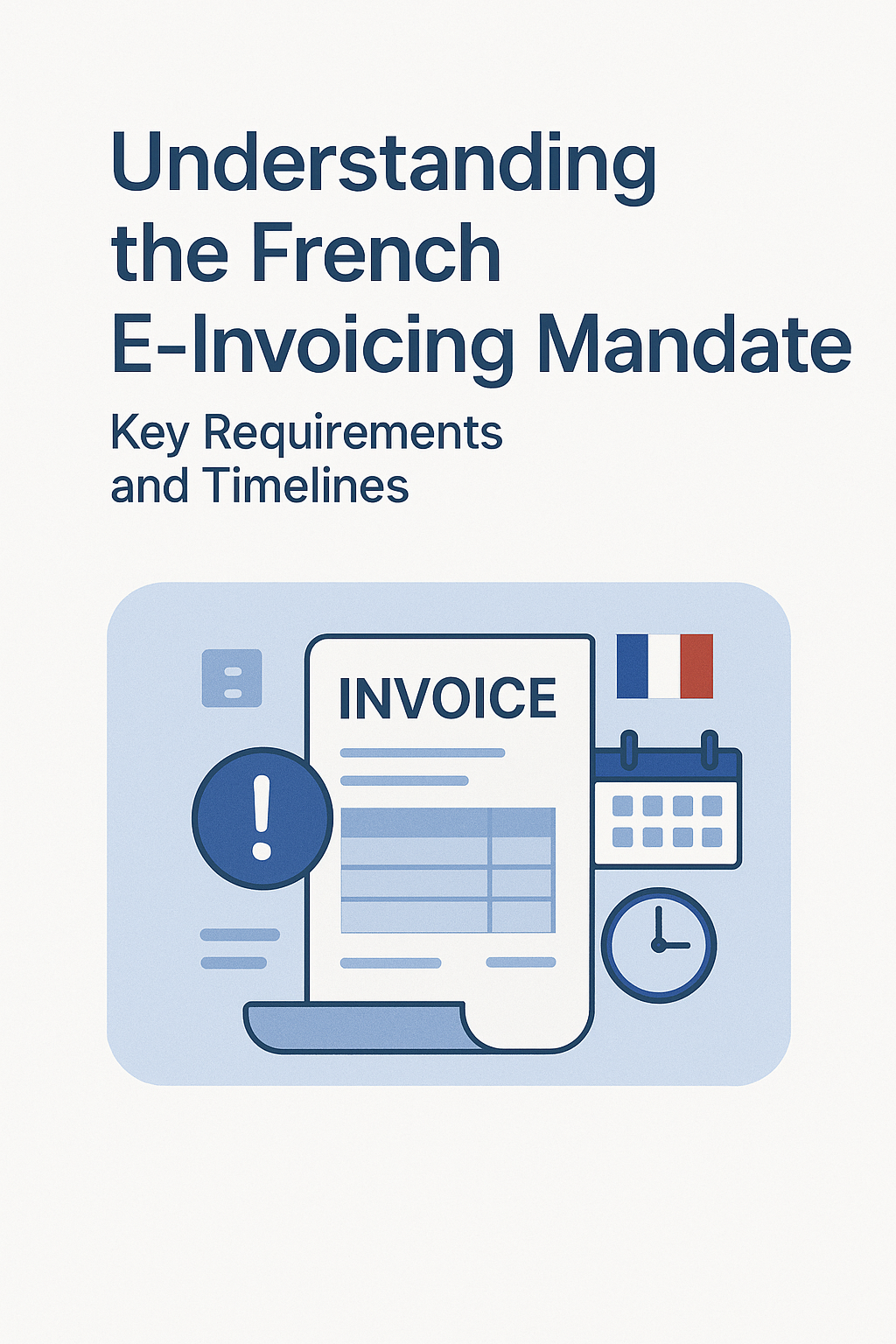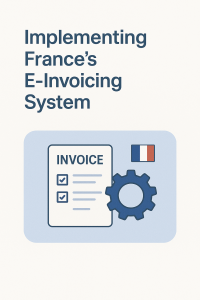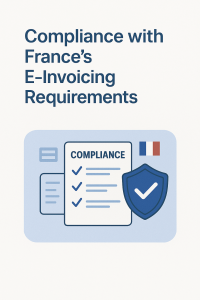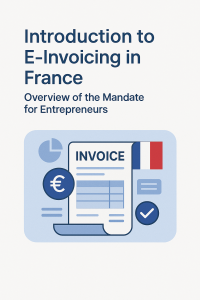Introduction: France is Going Digital with Invoicing
France is entering a decisive stage in its digital transformation of tax compliance. Starting September 2026, all businesses registered for French VAT will need to comply with new electronic invoicing (e-invoicing) and electronic reporting (e-reporting) rules.
For foreign entrepreneurs—whether you are planning to establish a company in France or you are already VAT-registered due to cross-border activities—these rules will affect how you create, send, receive, and store invoices.
This article provides a clear and structured overview of what France’s e-invoicing reform means, why it is happening, and how you can prepare. It is the first part of a four-article series that will guide you step by step, from understanding the basics to implementing a compliant system in practice.
Why France Introduced Mandatory E-Invoicing
France’s reform is not happening in isolation. Across Europe, governments are adopting digital tax controls to reduce VAT fraud, improve transparency, and automate reporting.
In France:
- VAT fraud is estimated at over €20 billion per year. Digital invoicing helps close the gap.
- Efficiency gains: Structured e-invoices allow businesses to automate accounting, improve cash flow visibility, and reduce administrative costs.
- EU alignment: France’s system is designed in line with the EU’s “ViDA” (VAT in the Digital Age) initiative, ensuring interoperability in the long term.
For entrepreneurs, this reform is not just about compliance. It is also a chance to modernize your finance function, adopt automation, and gain better control over your French business operations.
Key Terms: E-Invoicing vs. E-Reporting
Before going further, it is essential to distinguish the two pillars of the reform:
- E-invoicing: Applies to domestic B2B transactions (business-to-business sales between companies established in France). Invoices must be issued in a structured electronic format and transmitted through a certified channel.
- E-reporting: Applies to transactions not covered by e-invoicing, such as:
- B2C sales (business-to-consumer)
- Cross-border B2B transactions (imports, exports, intra-EU supplies)
E-reporting requires sending summary data (not full invoices) to the French tax administration.
👉 In short: all businesses must receive e-invoices, some must issue them depending on their size and timeline, and all must report out-of-scope transactions.
The Legal Framework
France’s e-invoicing reform is anchored in several official texts:
- Ordinance n° 2021-1190 (September 2021) – established the principle of mandatory e-invoicing and e-reporting.
- Finance Law 2024 (Article 91) – confirmed the revised calendar after delays.
- DGFiP (Direction Générale des Finances Publiques) specifications – provide technical and operational rules.
Understanding these references is not mandatory for day-to-day operations, but they show the legal certainty behind the reform.
The Calendar: Who Must Comply and When
The rollout is progressive, based on company size:
- From 1 September 2026
- All businesses must be able to receive e-invoices.
- Large companies and intermediate-sized companies (ETI) must start issuing e-invoices.
- From 1 September 2027
- Small and medium-sized enterprises (SMEs) and micro-businesses must start issuing e-invoices.
The same phasing applies to e-reporting obligations.
👉 This means that even if you are a small foreign entrepreneur setting up in France, you will need to be ready to receive e-invoices by 2026 and to issue/report by 2027.
The Y-Model: How France’s System Works
France has chosen a “Y-model” for its e-invoicing architecture. In practice, invoices and data can flow through two main routes:
- Via Partner Dematerialisation Platforms (PDPs):
- Private platforms registered by the tax authority (DGFiP).
- They can exchange invoices between each other and transmit mandatory data to the State.
- Via the Public Invoicing Portal (PPF):
- Managed by DGFiP.
- Centralizes functions such as directory management, data collection, and monitoring.
Additionally, businesses can use Dematerialisation Operators (ODs) to connect, although these do not have the same authority as PDPs.
This model ensures flexibility and interoperability. It also connects with Peppol, the European standard for e-document exchange, which France officially joined as a Peppol Authority in July 2025.
Accepted Invoice Formats
Invoices must be issued in one of three structured formats:
- UBL (Universal Business Language)
- UN/CEFACT CII (Cross Industry Invoice)
- Factur-X (a hybrid format combining a PDF/A-3 file and XML data)
👉 For foreign entrepreneurs, Factur-X is often the easiest entry point since it allows invoices to remain human-readable while being compliant.
New Mandatory Data on Invoices
In addition to existing invoice requirements, new fields will become mandatory:
- Customer’s SIREN number (French business ID)
- Delivery address (if different from client’s address)
- Type of operation (goods, services, or both)
- VAT accounting on debits (if applicable)
These requirements start in 2026 for large companies and 2027 for SMEs and micro-businesses.
Who Is Concerned?
- French subsidiaries of foreign groups → Fully in scope for e-invoicing (domestic B2B) and e-reporting.
- Foreign businesses VAT-registered in France without a permanent establishment → Must comply with e-reporting for in-scope transactions and be able to receive e-invoices from French suppliers.
- Foreign businesses without French VAT registration → Not directly impacted, unless transactions in France create a VAT obligation.
Benefits for Foreign Entrepreneurs
While mandatory, the reform brings concrete benefits:
- Simplified VAT compliance: Pre-filled VAT returns will reduce manual errors.
- Faster payment cycles: Automated invoice processing accelerates cash collection.
- Standardization: Easier integration with French partners and suppliers.
- Audit-readiness: Automatic data sharing with DGFiP reduces the risk of disputes.
Risks of Non-Compliance
Ignoring these rules is not an option. Risks include:
- Rejection of non-compliant invoices (suppliers may refuse them).
- Fines for missing, late, or incorrect e-invoicing/e-reporting.
- Tax audits triggered by discrepancies between reported data and VAT returns.
For foreign entrepreneurs, non-compliance could also mean losing credibility with French partners and clients.
Practical Example: A Non-Resident Company
Imagine a German SaaS company with French clients:
- If it only sells to consumers (B2C), it must e-report transaction totals.
- If it has a French subsidiary, that entity must issue domestic B2B e-invoices via a PDP or PPF.
- If it is VAT-registered without a subsidiary, it must be able to receive e-invoices from French suppliers and report certain sales.
Preparing for What Comes Next
Even though 2026 seems far away, preparation should start now:
- Understand your French VAT footprint – Are you incorporated or non-established VAT-registered?
- Review your invoicing system – Can it generate UBL, CII, or Factur-X?
- Identify your connection route – Will you contract a PDP or rely on the public portal?
- Plan for new invoice data – SIREN, operation type, etc.
- Anticipate training – Your finance team must understand lifecycle statuses (acceptance, rejection, payment updates).
Conclusion: Your First Step Toward Compliance
France’s e-invoicing reform is more than a legal obligation—it is a fundamental change in how businesses interact with each other and the tax authority.
For foreign entrepreneurs, the first step is to understand the basics: what e-invoicing and e-reporting are, who is concerned, and when deadlines apply.
In Article 2 of this series, we will go deeper into the scope, obligations, and new rules—including the specific impact on foreign entrepreneurs and subsidiaries.




